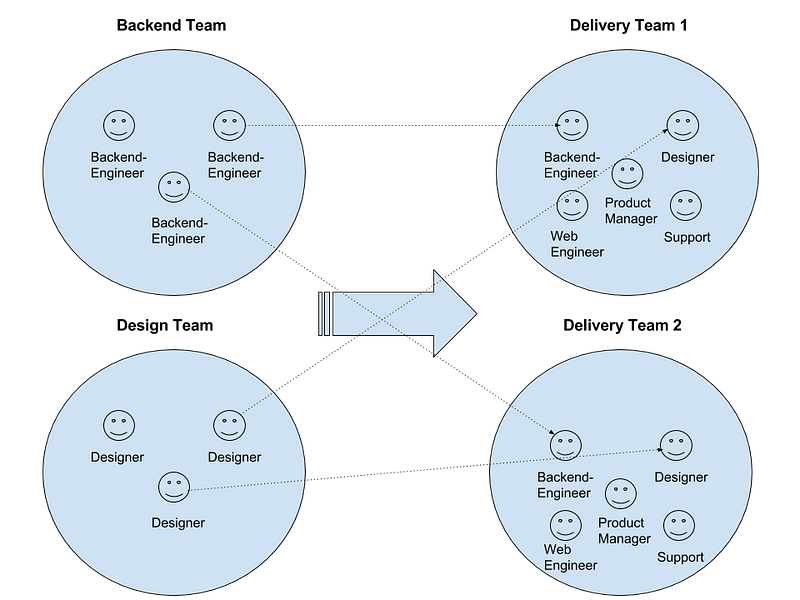
One of our largest departments within Ocado Technology recently undertook a revolutionary self-selecting restructuring exercise, changing the entire structure of the department whilst allowing all team members to choose which team they would like to work in going forward. The need came about because multiple teams were stretched, working across two major business propositions and context switching between them. The goal was that following the restructure there would be a clear split between teams working on two different business propositions, such that each of those teams could really focus on that product.

The overall aim of this restructure was to achieve greater alignment, autonomy and purpose.
Following the principle that a collaborative and distributed approach is often the best way to solve a complex optimisation problem, we decided to take a full day as a whole department to stop work and have a facilitated event to negotiate the moves amongst the five new teams. We did a lot of thinking and preparation prior to this day and the teams used a set of constraints around team size and experience levels to guide their decisions.
The plan going into the event was shared well ahead of time to allow people to get their questions in (and added to a shared FAQ forum) and to be sure the concepts were clear going into the day. Alongside this, we ran multiple “townhall” sessions where people could air their concerns and ask their questions openly. We hoped that at the end of the process we would have well-rounded, committed teams ready to face the new challenge.
There was a certain amount of ad-libbing and practical adjustments on the day, but on the whole it unfolded according to the plan:
– First, a pitch for each team by the Product Owner, covering the vision/roadmap and why the team is super cool and awesome. There was also a set of target criteria for each team as a guide for what we were looking to achieve in each area.
– Next, multiple iterations where we:
1. Assigned or moved ourselves/each other between teams until we’ve addressed any identified issues in the previous iteration.
2. See if we had met the pre-defined criteria for each team.
3. Repeat until we run out of time or we meet all of the requirements and everybody is happy and committed to the team that they are in.
Fuelled by 18 pizzas, we completed three exhausting rounds of moves and peer voting. At the end of each round, we (everyone, including Product Owners and Team Leads) voted on the viability of each team. From this we measured two scores: an intra-team score (the people in that team scoring the viability of the team), and an inter-team score (the rest of the people scoring the viability of that team). This lead to a few interesting dynamics, for example one of the teams gave themselves a high intra-team score, but scored low on the inter-team vote. They then gave a pitch justifying their viability as a team, and were able to dramatically increase their inter-team score in the next round.
The first round was deliberately obviously suboptimal, so that everyone was motivated to suggest changes and improvements and become comfortable with doing so in a very “safe” way. Naturally, this configuration had dramatically lower scores! This encouraged a large amount of movement in the following rounds, as we had hoped.

Essential to finding a viable solution was an appreciation from all of the ‘greater good’ of Ocado Technology. On the day, some people chose to make some really big compromises in order to serve the greater good and allow us to form balanced teams that are all capable of smashing out quality software.
After the final round of voting we then took a quick anonymous happiness reading by each dropping a green, yellow or red lego piece into a box. Although they were not perfect, we were extremely pleased the results, considering that our original goals was “at least 50% happy”.

The very next morning we did a big-bang desk move:

We’ve since kept a close eye on the impact of the shuffle-up by measuring the things that matter most to us: throughput and team happiness. There was an expected initial dip in throughput as many people got up to speed on new products they had not worked on before and as new teams gelled and got to know each other. But the throughput three months on has risen higher than before the change and still rising. Improvements in team happiness (measured before and after by Spotify’s “health-checks”) were noteworthy from straight after the restructure.
In terms of the solution itself: we are delighted. Every team has a reasonable level of experience whilst a healthy number of people have chosen to change domain. It is a vastly better result than we could have hoped for had we chosen a top-down approach and the sense of autonomy it has created is invaluable. It seems that teams and individuals have a stronger sense of ownership than ever before and that they are taking quality more seriously than ever before. This did have an up-front cost in terms of short term throughput, but the long term benefits certainly justify it.
James Lohr, Ocado Tech Department Head






